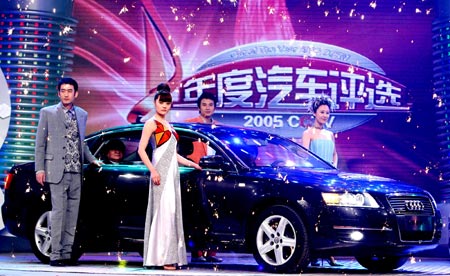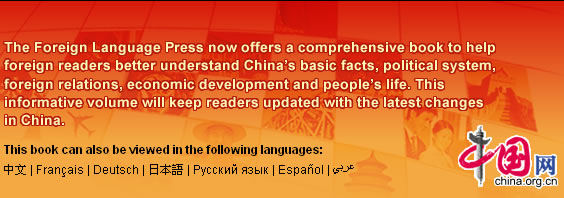China has maintained mutually beneficial relations in various fields and at different levels with major countries in the world. In 2006, these relations continued to grow.
China-US Relations
In 2006, Sino-US relations were on a stable and sound path. Bilateral relations were characterized by frequent high-level visits and personnel exchanges, as well as deepening cooperation in various fields.
 |
Chinese President Hu Jintao (second from right) paid a state visit to the United States in April 2006. Pictured are the presidential couple of China, Hu Jintao and Liu Yongqing, and U.S. President Gorge W. Bush and first lady Laura Bush greeting guests at the White House.
Leaders of the two countries continued to communicate with each other and reached consensus on promoting the constructive bilateral relations of cooperation. On April 18-21, 2006, Chinese President Hu Jintao visited the United States at the invitation of his U.S. counterpart George W. Bush. The two presidents agreed that China and the United States share significant strategic interests, the future for mutually beneficial cooperation is bright, and sound relations between the two countries are crucial to promoting peace, stability and prosperity in the Asia-Pacific region as well as the world. On July 16, President Hu met with President Bush again on the sidelines of the outreach session of the Group of Eight (G8) summit in St. Petersburg, Russia. On November 19, Chinese and U.S. presidents held in-depth talks while attending the APEC Economic Leaders' Meeting in Hanoi, Viet Nam. They exchanged views on regional and international issues of common concern. Frequent meetings between heads of state and other high-ranking officials signaled a new level in Sino-U.S. political relations.
On November 8, 2006, China and the United States held the Third Strategic Dialogue. The two sides exchanged in-depth views on major regional and international issues of common concern. On December 14-15, the First China-U.S. Strategic Economic Dialogue was convened in Beijing The dialogue primarily covered macroeconomic issues of strategic, long-term significance and of broad impact. The Second China-U.S. Strategic Economic Dialogue took place in the United States in May 2007. To be held biannually, such dialogues are expected to enhance mutual confidence.
In terms of trade and economic relations, statistics from China's Ministry of Commerce show that, up to November 11, 2006, trade volume between China and the United States reached $238.7 billion, up 24.6 percent year on year. China's imports from the United States stood at $53.9 billion, a 23 percent increase over the same period in the previous year. China has been the fastest growing importer of U.S. goods in recent years. At present, the United States is the second largest trading partner of China and the largest importer of Chinese products; whereas China is the third largest trading partner of the United States and the fourth largest importer of U.S. goods.
As Sino-U.S. relations continue to grow, China and the United States have been finding more and more common stakes in international affairs. The two countries have coordinated positions and cooperated in such fields as the North Korean and Iranian nuclear issues, antiterrorism and non-proliferation of nuclear weapons. The two countries have also reached consensus on maintaining peace and stability across the Taiwan Strait. China is the largest developing country in the world, while the United States is the largest developed country. Harmony between the two countries will bless both sides whereas collision will wreck both. Hence, China and the United States must deepen communication and mutual understanding, and enhance the building of consensus and confidence. Friendly relations between the two countries will not only benefit the two peoples but also promote world peace.
China-EU Relations
Since forging a comprehensive strategic partnership in 2003, China and the European Union (EU) have been on good terms, which is reflected in deeper mutual trust and more frequent exchange of high-level visits. President Hu and Premier Wen Jiabao visited Europe in 2006; while many European heads of state and government, such as Chancellor Angla Merkel of Germany and President Jacques Chirac of France, paid visits to China. Close contacts between leaders promoted mutual understanding between China and the EU.
 |
The EU is China's largest trading partner. Pictured is the Audi A6 luxury sedan produced by the FAW-Volkswagen Automobile Co. Ltd.
In September 2006, Premier Wen met with EU leaders at the Ninth China-EU Summit held in Helsinki, capital of Finland. The two sides held dialogue on political issues and made progress in cooperation in trade and commerce, science and technology, energy, environmental protection as well as the non-proliferation of nuclear weapons. At the meeting, China and the EU announced the launch of negotiations for a new comprehensive framework agreement, marking a new phase of China-EU ties. By then, two China-EU strategic dialogues at the vice ministerial-level had been held. The dialogues covered not only bilateral links but also regional and international issues. On October 24, 2006, the EU officially unveiled its new China policy paper entitled "EU-China: Closer Partners, Growing Responsibilities." The paper notes that China-EU relations are becoming more and more mature and pragmatic. With a closer partnership, responsibilities on both sides have increased.
In 2006, trade between China and the EU saw rapid expansion. The total bilateral import and export volume shot up 24 percent on a year-on-year basis. In the first 10 months of 2006, trade volume reached $218.9 billion. Today, the EU is the largest trading partner of China, and China remains the second largest trading partner of the EU. The EU's investment in China continues to grow. Businesses from the EU have established more than 40,000 enterprises in China, with a total investment of $50 billion. The EU remains the largest technology supplier to China. In the first 10 months in 2006, China and the EU signed more than 2,000 agreements on technology transfer to China worth more than $7.7 billion, accounting for 40 percent of the total value of technology transfer contracts that China had signed with foreign countries.
China-Russia Relations
The strategic partnership and mutual political trust between China and Russia reached a new high in 2006. The year saw close person-to-person contacts and the most frequent high-level visits between the two countries. President Hu met with Russian President Vladimir Putin five times in 2006 alone. Exchange of visits also took place between top legislators and prime ministers, as well as high-ranking officials of government departments of the two countries.
 |
Russia and China are expanding economic and trade cooperation. Pictured is a Russian crude oil train entering China.
China and Russia worked more closely together in international affairs in 2006. The two countries pushed for a feasible solution to the North Korean and Iranian nuclear issues. On January 12, 2007, China and Russia vetoed a draft UN Resolution on Myanmar's human rights situation backed by some Western countries in the Security Council, illustrating their common grounds in opposing interference in other countries' internal affairs under the pretext of human rights protection.
Statistics from China's Ministry of Commerce show a record high bilateral trade volume of $33.4 billion in 2006 between China and Russia, up 15 percent from that in 2005. To facilitate dynamic trade and economic cooperation, China and Russia are adjusting the structure of bilateral trade.
China successfully hosted the "Year of Russia" program in 2006, while the "Year of China" program is launched in Russia in 2007. This indicates a high level of mutual trust and close strategic cooperation between the two countries, and reflects the expectations of Chinese and Russian leaders on promoting friendly and mutually beneficial relations of good neighborliness, and the desire and determination of the two peoples to become "good neighbors, close partners and friends."
China-Japan Relations
Relations between China and Japan improved in 2006. Japanese Prime Minister Shinzo Abe's visit to China in October 2006 put an end to the frosty relationship between the two countries, which soured after former Japanese Prime Minister Jinichiro Koizumi repeatedly visited the war-related Yasukuni Shrine despite the Chinese side's opposition. It is noteworthy that Prime Minister Abe chose China as the destination of his first journey abroad after assuming the top government position, whereas his predecessors usually visited the United States first. Abe is the first Japanese prime minister to do so after World War II. The visit was considered to indicate the Japanese Government's desire to improve bilateral relations, which were characterized by "warm economic cooperation but lukewarm political ties."
 |
Two Japanese guests are cooking in a Chinese kitchen. China and Japan are maintaining close nongovernmental exchanges.
On November 18, 2006, President Hu met with Prime Minister Abe again on the sidelines of the APEC Economic Leaders' Meeting in Hanoi, Viet Nam. In April 2007, Premier Wen visited Japan, which was the first time that a Chinese premier had visited Japan in the past seven years. Various departments of the two governments have been discussing middle- and long-term plans for cooperation. Military exchanges between the two countries also resumed. A cultural exchange fair designed to promote understanding between the two countries, the "2006 Chinese Culture Festival," was held in Tokyo from November 17 to December 17, 2006.
The warming of political ties boosted economic and trade cooperation between China and Japan. Statistics from China's Ministry of Commerce show that bilateral trade reached $207.36 billion in 2006, up 13 percent year on year. This was the first time that the trade volume between China and Japan had topped $200 billion. Japan has become the third largest trading partner of China. With a total investment of $57.45 billion in China up to the end of November 2006, Japan is the second largest investor in China. In the first 10 months of 2006, Chinese companies signed contracts to invest a total of $12.1895 million in Japan. Total actual investment from China to Japan to date is $180 million.
The year 2007 marks the 35th anniversary of the normalization of relations between China and Japan. As long as both countries abide by the spirit of "taking history as a mirror and looking forward to the future" and handle their differences and disputes appropriately, bilateral relations will take a new bigger step ahead.








